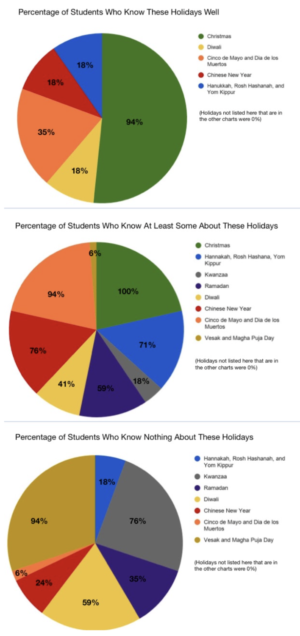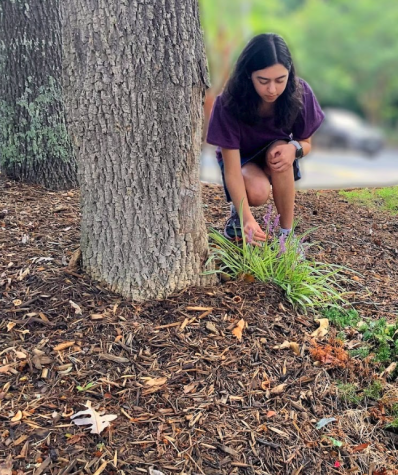Giving the Gift of Holiday Awareness: Understanding the Cultural Diversity that Should Unite Our Community
April 13, 2021
The holiday season has arrived. Thanksgiving just ended, and now winter break seems nearer than ever: two weeks of no school or homework! Everywhere you walk, holiday spirit fills the air. The Christmas trees have been put up, and decorations cover the entire school. Christmas music streams in classrooms of teachers rewarding students for their hard work, and some especially generous teachers distribute Christmas candy. Everyone is chatting about their holiday plans, traditions and Christmas desires. Students and teachers express their well wishes to each other. It truly is the most wonderful time of the year—that is, if you are a Christian.
Flash back two months. Diwali has arrived. Hindu families have decorated their homes with bright lights and statues of gods, recited their prayers, prepared elaborate meals, wrapped gifts and bought fireworks for a nighttime display with family and friends. The Hindu students arrive at school in a positive mood, immersed in the holiday spirit; however, one look around the school drains their good spirits. People walk by in the bare, dull hallways without a glance. No one even says “Happy Diwali.” As the Hindu students eagerly anticipate the upcoming evening of big plans, th
e teachers pile them up with homework without a second thought to even acknowledge the most important holiday of their Hindu students’ religion.
Flash forward again. At the same time, Jewish students are awaiting Hanukkah, a holiday that lasts eight days. Muslim students are preparing for Ramadan, thirty days of fasting. Africans and students who identify as African American are thinking about Kwanzaa, a seven day celebration. Asian students look ahead to the Chinese New Year. All of these holidays are much longer than the one day of Christmas that so many people get excited about months in advance, yet there appears to be no real discussion about them. The attention is not split between the holidays occurring at the same time. Different sections of the hallway are not dedicated to the different holidays. Music is not shuffled with songs from every holiday. People do not send holiday wishes to those who celebrate other religious days. Is this what every non Christian student in America, including those who attend Latin, should be born knowing that this is their fate?
Why is this? The problem lies in the fact that students are not educated about other cultures and their holidays. Data from a student survey shows that the majority of students at Latin know virtually everything about Christmas and practically nothing about holidays from minority groups. The numbers do not lie.

Many students, including but not limited to Christians, believe that different cultures at the school are not represented fairly. Sophia Cartafalsa ‘24 agreed with the data. Moreover, because Latin’s world language instruction is limited to Spanish, French, and Latin, students’ insight on the world seems restricted. “I do not think all cultures are celebrated equally at Latin because they do not teach us about all the different cultures at school. I have learned a good amount about Spanish holidays in Spanish class; however, if someone does not take Spanish class then they might not know the same holidays I do. I feel Latin should educate all students about all the different cultures’ holidays,” Cartafalsa said. From the perspective of a non-religious student, Sophie Egan ‘21 said, “Being white there isn’t a culture to really be represented, though Latin doesn’t represent any other cultures. Being atheist I also don’t really mind people sharing their religions and things but Latin only shows Christmas and Christianity.” Lilly Egan ‘24, a multicultural student, offered her unbiased insight that comes from being part of two different cultures. “As someone that is half-Christian and Jewish, I
do believe the school does seem to favor the Christian religion a little more. I do feel like they could do a little more for the other religions as well,” Egan ‘24 said. A Hindu student, Shreeya Sanisetty ‘24, notices the cultural divide at Latin. “I think our religion is not expressed as thoroughly as the other ones are, like Christianity,” Sanisetty said.
Why is it important to discover information about others’ cultures and to teach the community about ours? Students shared their input. “I think it is important to learn about other cultures in order to be in tune to the rest of the world and be aware of their traditions in order to avoid prejudice or ignorance of them. It also promotes a respect and understanding that people from different parts of the world are different,” Hailey Kim ‘23 said. Expanding on this point, Egan ‘21 said, “I think that everyone should be able to share their cultures because it enriches our community and I’d love to learn more about other cultures and not just have Christianity shown.” Agreeing with these statements, Anna Wasko ‘24 said, “I think it is important to share culture and learn from others because it creates more awareness and diversity within communities. You can’t live your whole life being oblivious to other cultures, so you should go out and learn from others who are willing to share their cultures.” Thinking deeply beyond school life, Aditya Banerjee ‘24 said, “If we are all confined to our own bubbles without exploring and learning other cultures it will be near impossible to be united and to form thoughtful opinions.”
We cannot just recognize that there is a problem; the majority of the work lies in the solution. Once we identify the different cultures at the school (see pie charts), we need to compile a list of the major holidays they celebrate. Next, we must formulate a plan to include everyone from all backgrounds and promote diversity. Look at what is already done for Christmas. In the Inlusrate Orbem, parents put up a Christmas tree with ornaments representing all of the seniors, regardless of whether or not they are Christians. Other Christmas trees with various decorations are placed around the school, and wreaths are hung on the outside of buildings. Teachers allow Christmas music to be played and hand out candy such as Christmas chocolates and candy canes. However, students are not looking for more assemblies or added curriculum; they will lose interest easily. Instead, appreciation for more diverse cultural holidays should be incorporated in a fun way. For other holidays, decorations including menorahs, lights and traditional religious symbols should be displayed in every building. Posters with information about the holidays should be pasted on the walls to teach important facts, possibly with a time dedicated to letting students read them. There should be days dedicated to each holiday where traditional food is offered for everyone to taste. During a certain class (most likely history), teachers should provide traditional games played during the holiday so students can experience the joy of participating in them. In this same class, teachers should play a short, entertaining but educational video about holiday customs. If students are comfortable, the teacher can leave room at the end of class to ask if anyone belonging to that specific culture would like to explain the holiday’s meaning to them and their family’s way of celebrating.
Ideas can be tossed around, but nothing will happen if action is not taken. I alone as one student cannot make change; it requires the support of others. Administrators at the school must agree with this and help execute these proposals into reality. Change can be small, but if no one speaks up when they feel something is not right, no improvements will be made. I hope to see a more diverse and inclusive school before I graduate from Latin.



Richard Harris • Apr 19, 2023 at 4:06 pm
Great article. I like your proposal, too. We might consider using some advisory time to celebrate and learn a little more about all the cultures that make up our advisory groups and our larger community. We need to always look for ways to foster community and belonging.